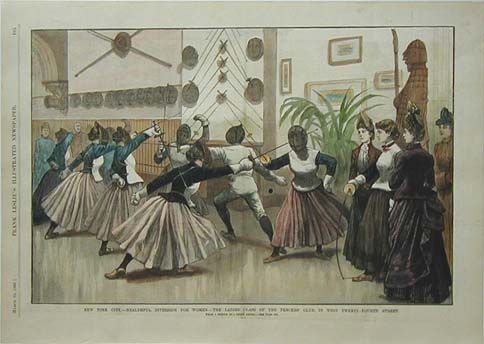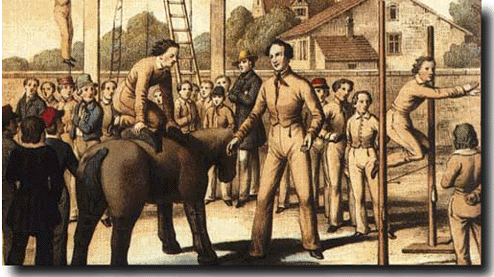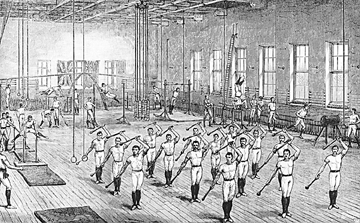
By the 1890s, the benefits of physical culture had become well-established. There was a thriving mail-order business in supplying home exercise apparatus, and publishers turned out dozens of manuals describing the latest calisthenic and dietary programmes.
The Bartitsu Club, which Barton-Wright also called his "School of Arms and Physical Culture," was one of several London academies dedicated to self-improvement through exercise. It was described by journalist Mary Nugent as
A huge subterranean hall, all glittering, white-tiled walls, and electric light, with �champions� prowling around it like tigers.
Other famous gymnasia included the Inns of Court School of Arms, the German Gymnasium, the Orion Gymnastics Club, and the studio operated by the celebrated body-builder Eugen Sandow. Most of these academies offered a combination of gymnastics, calisthenics, apparatus exercises and combat sports.
Gymnastics training included acrobatic vaulting on the pommel horse, rope climbing and swinging, parallel bars, trapeze, rings, high-jumping, ladder-scaling, etc. Many of these exercises were borrowed from the German Turnverein movement, founded by Friedrich Ludwig Jahn in the early 1800s. This movement was highly influential in the design and supply of gymnasia throughout Europe, the USA and the British Commonwealth.
Calisthenic routines usually combined movements drawn from dance, military drill and therapeutic exercise. They tended to be drawn either from the strenuous "heavy gymnastics" of the German school, or the "Swedish System," which emphasized grace and co-ordination and had been developed in the early 1800s by Pehr Henrik Ling. There was considerable rivalry between proponents of these different approaches, but most gymnasia incorporated elements from both styles.
Indian club-swinging was a very popular exercise that had been imported to England by Colonial troops serving in India. The wooden clubs were twirled or swung in a variety of circular and elliptical patterns, often combined with lunging steps and turns to provide a good whole-body exercise routine. Wands (short poles) and dumb-bells (small hand-held weights) were likewise employed.


